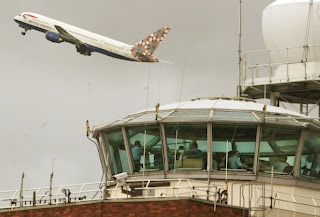How can television signals be used to track aircraft?
An experimental radar system, due to be switched on in June 2013, will use ordinary television signals to track aircraft flying over London. How will it work?
Radar, which is an abbreviation of “radio detection and ranging”, detects distant objects by bouncing radio waves off them. In a conventional radar system, these radio waves are emitted by a rotating antenna that sends out radio pulses and listens out for reflected signals that have bounced off aircraft. The time delay between emitting the pulse and detecting its reflection allows the aircraft’s distance to be determined. Its speed and direction can also be calculated, because the aircraft’s motion causes a slight shift in the frequency of the reflected signal due to the Doppler effect (the phenomenon that also causes a passing ambulance’s siren to change pitch).
But this is not the only way to build a radar. Another approach, called “passive radar”, relies on existing signals, such as television and radio broadcasts, to illuminate aircraft. This involves using multiple antennas to listen out for signals from broadcast towers, and for reflections of those signals that have bounced off aircraft, and comparing the two. With enough number-crunching, the position, speed and direction of nearby aircraft can then be determined. Passive radar requires a lot of processing power, but because there is no need for a transmitter, it ends up being cheaper than conventional radar. It also has military benefits, because it enables a radar station to detect objects covertly, without emitting any signals of its own. Lockheed Martin, a defence contractor, launched the first commercial passive-radar system, called Silent Sentry, for military use in 1998.
The new passive-radar system being deployed over London, called MSPSR, is for civilian use. It will be evaluated to see how passive radar might be incorporated into Britain’s air-traffic control systems. The use of television signals might, for example, work better in areas where conventional radar coverage is currently patchy, or where there is interference caused by wind turbines. Will soap operas and news bulletins end up helping to direct aircraft in London’s busy skies? Stay tuned.
Source: http://www.economist.com/blogs/economist-explains/2013/03/economist-explains-how-television-signals-track-aircraft




Comments
Post a Comment